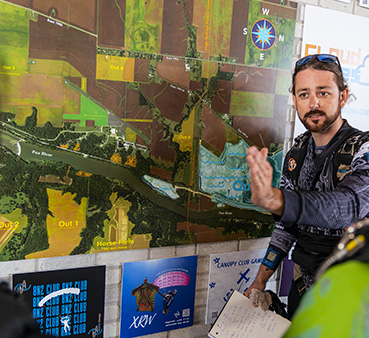Above: Photo by Matt Jackson.
The evening of December 31, 1999, was dark and moonless. Twelve jumpers and I exited a King Air at 14,000 feet with the goal of entering the new millennium in freefall. In order to leave 1999 in an airplane and land in 2000 under a parachute, the timing of the jump was everything.
I could tell that we were already well past the drop zone when Carolyn Clay got the green light for the door, looked out, immediately screamed “cut!” and started the climb out. There was no time for a go-around if we wanted to jump into the new millennium, although that would have been the safer thing to do.
It was immediately clear that the jump would be spicy. The freefall was a zoo, with the attempted 13-way building to nine. But after my parachute opened, things got really interesting. Although I had jumped at this DZ for many years, I looked directly below myself and recognized nothing. Nothing! So, I expanded my field of view a bit and located the town lights, which gave me a familiar landmark. I was then able to locate the airport, which was about two miles away ... obviously too far to reach from 2,000 feet under an elliptical parachute loaded at 2:1.
Fortunately, seven years of driving to the same airport made me familiar with the nearby roads and fields. I located a yard that had some ground lighting and, realizing there might be power lines running from the road to the house, elected to land in the back yard even though it was darker. Two others landed near me. We celebrated surviving and walked off to locate the rest of the load. A few of the other jumpers didn’t fare so well, having landed in trees or on other obstacles. Fortunately, the worst injuries of the night were a sprained ankle and a few scrapes and bruises. Welcome to the new millennium!
In the early 2000s, multiple incidents related to poorly executed off-field landings occurred each year. Consequently, USPA updated Skydiver’s Information Manual Section 5-1 to include off-field landing recommendations, which provide some basic guidelines for landing off the drop zone. If you haven’t read it in a while, it’s worth a review, no matter how many jumps you have.
Preparation
Without a doubt, day or night, skydivers prefer to land in a familiar main landing area. Large, manicured grass areas free of obstacles make landing a parachute much easier! But from your first solo jump until you hang up your parachute for good, you must always be prepared to handle landing off the drop zone. Bad spots, strong and unusual winds and deployments at unplanned altitudes (high or low) are just a few of the factors that can lead to landing off.
Careful planning and preparation before each jump will help you land in the designated landing area. It is important to know the direction of jump run, the wind speeds and directions at various altitudes from ground level up to exit altitude, your expected exit and opening points based on those winds and a plan for the canopy descent from opening to final touchdown. Without this information, you’ll have no way to know whether you are where you need to be when you exit the airplane and begin your descent. Regardless of whether you are exiting the airplane first or last, soon after the exit you should look straight down and see where you are above the ground. This gives you a chance to increase your breakoff and deployment altitudes (if safe to do so) when the spot is long, so you’ll have more time under canopy to reach the landing area.
 Photo by Josh Reuck.
Photo by Josh Reuck.Land Safe, Not Close
Even if you always prepare and check weather conditions, it’s not a perfect world, so there’s no doubt that you’ll eventually find yourself having to deal with an unplanned off-field landing. The good news is that preparation pays off here, too. Knowing the wind speed and direction will help your situational awareness and decision-making skills when you look down after opening and realize you must choose an alternate landing area because you are too far out. Solid accuracy skills are also extremely helpful when landing in an unfamiliar location.
Over the years, many skydivers have been injured or died from landing in trees or striking other obstacles after passing over large, open fields while attempting to land closer to the drop zone. Once you know you’re landing off the drop zone, there’s no point in landing a half mile closer if it means exposing yourself to landing hazards. It’s likely that someone from the drop zone is already heading your way to pick you up even before you land, so avoid the temptation to keep flying closer to the airport when you have safe alternatives directly below. A long walk is better than a short ambulance ride.
Once you have selected a safe landing area such as a large, open grass field, you will need to plan the rest of your descent, including your landing direction. Fly a standard landing pattern facing into the wind, if possible, for your final approach. Obviously, there won’t be any wind blades or a tetrahedron in the field, so look for smoke, flags or waves on open bodies of water to help you determine the wind direction. Be sure to keep track of the location of the nearest road and any nearby houses while you are high enough to take your attention off the landing area for a few seconds.
Avoid Low Turns
If you can’t determine the direction of the wind, pick a landing direction, plan your pattern into a large open area and then stick with it. Scan the area carefully for fences, tree stumps and other obstacles and make small adjustments to your landing spot as necessary. In most cases, you’ll want to land in the center of the field, but if the winds are strong, land as far downwind as possible from trees or other tall structures that can create turbulence.
It is much safer to land with the parachute flying straight and level, even if that means you are landing in a downwind direction. Making sudden, erratic toggle inputs or turning low at the last minute can be deadly, so if you must change heading, used braked turns to flatten out your angle of approach. Braked flight will also slow things down a bit. Performing a parachute landing fall (PLF) as you touch down will help reduce the chances of an injury.
Once you are safely on the ground, your next task is finding your way back to the drop zone. Carrying a cell phone makes calling for a ride easy, but if you don’t have one with you, you may need to hike to a nearby house. However, there’s a good chance that the drop zone has already sent a car in your direction. Check with your drop zone to see if they have established procedures for jumpers landing off, but at the very least, check in with manifest when you return. If your landing damaged any crops or other property, be sure to contact the landowner and offer to pay for the repairs. Your USPA membership includes third-party liability insurance that may help with the costs.
Off-field landings are a rare occurrence, but one we must always be prepared to handle. Careful planning and preparation before each skydive will help reduce the chances of experiencing one, but when that day comes, strong situational awareness and solid decision-making under canopy will help ensure you land safely.
 About The Author
About The Author
Jim Crouch, D-16979, landed in a field off the drop zone on his first skydive in 1993. He had a few more over the years, including the previously noted millennium jump, as well as a nighttime inner-city demo with costumes and a lousy spot that could be another article all on its own. He was USPA Director of Safety and Training from 2000-2018 and now spends his time happily flying other people’s airplanes for aerial survey projects.